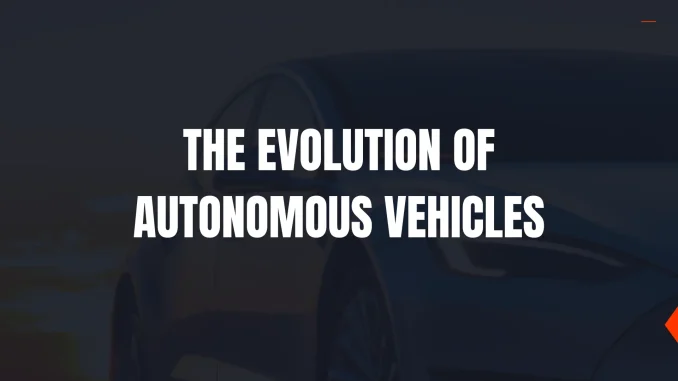
The concept of autonomous vehicles (AVs) has captivated imaginations and sparked debates for decades. From science fiction dreams to tangible technological advancements, AVs are no longer just a futuristic vision; they are increasingly becoming a reality. As we stand on the brink of a new era in transportation, understanding the evolution of autonomous vehicles and what lies ahead is crucial for navigating the future of mobility.
A Brief History of Autonomous Vehicles
The journey of autonomous vehicles began in the mid-20th century, with early concepts and prototypes emerging as far back as the 1920s. However, it wasn’t until the 1980s and 1990s that significant strides were made. Pioneering efforts by research institutions and automotive companies laid the groundwork for the modern era of AVs. Notable milestones include Carnegie Mellon University’s NavLab and the German company Daimler-Benz’s contributions, which demonstrated the feasibility of self-driving technology in controlled environments.
The 2000s saw the emergence of DARPA’s Grand Challenges, which spurred rapid advancements in autonomous vehicle technology by setting competitive challenges for research teams. These competitions showcased the potential of AVs and fueled investments in the development of advanced sensors, machine learning algorithms, and real-time data processing.
The Current State of Autonomous Vehicles
Today, autonomous vehicles have progressed from experimental prototypes to commercially available models. Companies like Waymo, Tesla, and Cruise have made significant strides in bringing AVs closer to mainstream adoption. The technology has evolved to include a range of capabilities, from advanced driver-assistance systems (ADAS) that offer features like adaptive cruise control and lane-keeping assistance to fully autonomous vehicles that can navigate complex urban environments with minimal human intervention.
Several levels of automation, as defined by the Society of Automotive Engineers (SAE), provide a framework for understanding the current state of AVs:
- Level 0: No Automation – The human driver is fully responsible for operating the vehicle.
- Level 1: Driver Assistance – Features such as cruise control or lane assistance are available, but the driver must remain engaged.
- Level 2: Partial Automation – The vehicle can control both steering and acceleration, but the driver must monitor the environment and be ready to take control.
- Level 3: Conditional Automation – The vehicle can handle most driving tasks autonomously, but the driver must be prepared to intervene if necessary.
- Level 4: High Automation – The vehicle can operate autonomously in specific conditions or environments, with no driver intervention required.
- Level 5: Full Automation – The vehicle is capable of complete autonomous operation in all environments, with no need for a human driver.
Challenges and Opportunities
As autonomous vehicles continue to evolve, several challenges and opportunities shape their development:
- Technological Challenges: Achieving full autonomy requires overcoming significant technological hurdles. Developing robust AI algorithms that can handle diverse driving scenarios, ensuring the reliability of sensor systems, and creating seamless integration with existing infrastructure are crucial for advancing AVs. Additionally, improving the safety and security of autonomous systems against hacking and cyber threats remains a top priority.
- Regulatory and Legal Issues: The regulatory landscape for AVs is complex and varies across regions. Developing consistent standards and regulations is essential for ensuring safety and facilitating widespread adoption. Legal issues related to liability, insurance, and traffic laws also need to be addressed to create a clear framework for autonomous vehicle operation.
- Ethical Considerations: Autonomous vehicles raise important ethical questions, such as how to program decision-making algorithms to handle emergency situations. Ensuring that AVs make ethical choices in scenarios involving potential harm to passengers, pedestrians, or other road users is a significant challenge that requires careful consideration and input from ethicists, engineers, and policymakers.
- Public Perception and Acceptance: Gaining public trust and acceptance is vital for the success of autonomous vehicles. Addressing concerns about safety, privacy, and the impact on jobs is crucial for building confidence in AV technology. Effective communication and education about the benefits and limitations of AVs can help ease public apprehension and encourage adoption.
What’s Next for Autonomous Vehicles?
The future of autonomous vehicles is poised to be transformative, with several key developments on the horizon:
- Enhanced Sensor Technology: Advances in sensor technology, such as LiDAR, radar, and cameras, will improve the accuracy and reliability of AV systems. Higher-resolution sensors and more sophisticated data fusion techniques will enhance the vehicle’s ability to perceive and respond to its environment.
- AI and Machine Learning: Continued advancements in AI and machine learning will enable more sophisticated decision-making and adaptive learning capabilities. AVs will become better at handling complex driving scenarios and adapting to new situations based on real-world experience.
- Integration with Smart Infrastructure: The integration of AVs with smart infrastructure, such as connected traffic signals and road sensors, will create more efficient and safer transportation networks. Vehicle-to-everything (V2X) communication will enable AVs to interact with other vehicles, infrastructure, and pedestrians, enhancing overall traffic management and reducing congestion.
- Sustainability and Efficiency: Autonomous vehicles have the potential to contribute to sustainability goals by optimizing driving patterns, reducing fuel consumption, and supporting the adoption of electric vehicles. Efficient routing and reduced traffic congestion can lead to lower emissions and a smaller environmental footprint.
- New Mobility Models: The rise of autonomous vehicles will likely lead to new mobility models, such as ride-sharing and shared transportation services. AVs can enable more flexible and cost-effective transportation options, potentially reducing the need for private car ownership and transforming urban mobility.
Leave a Reply